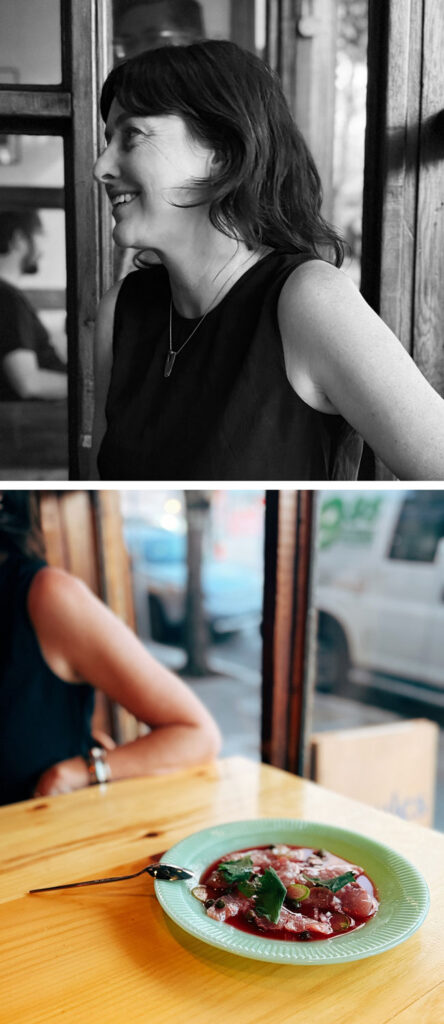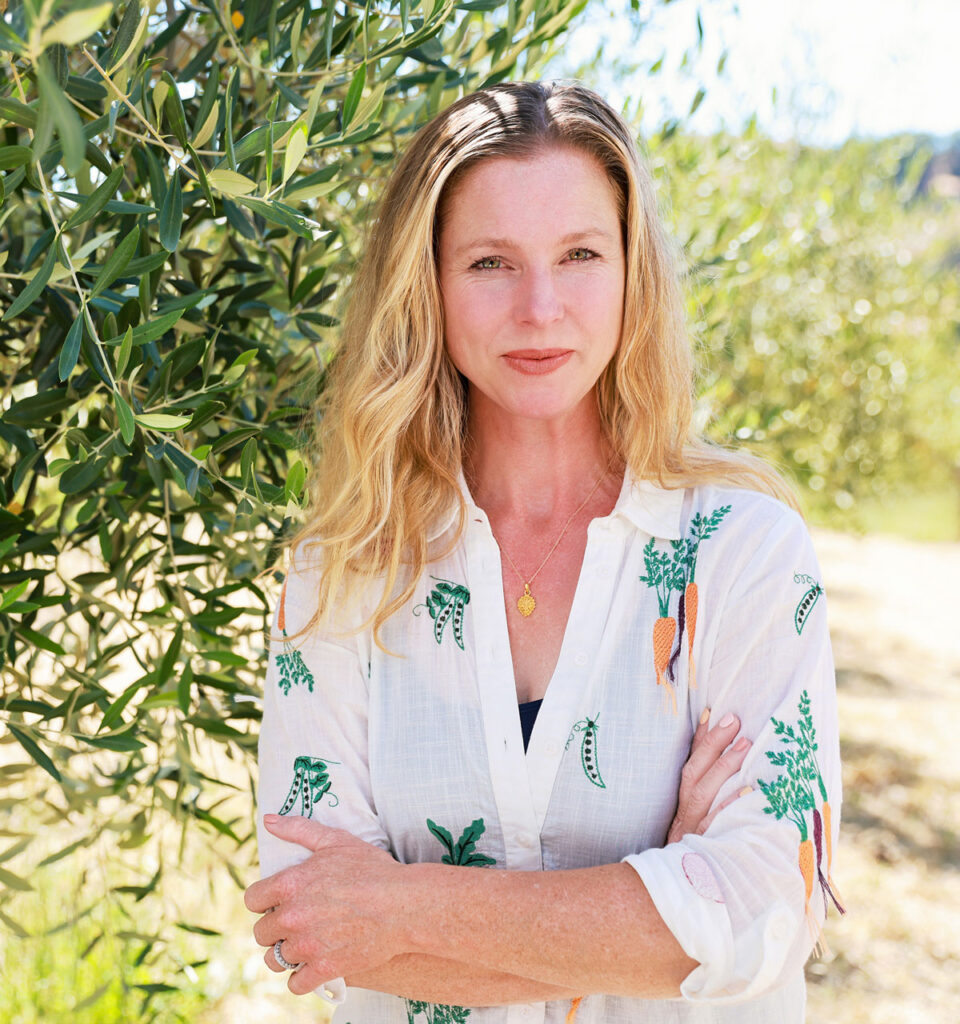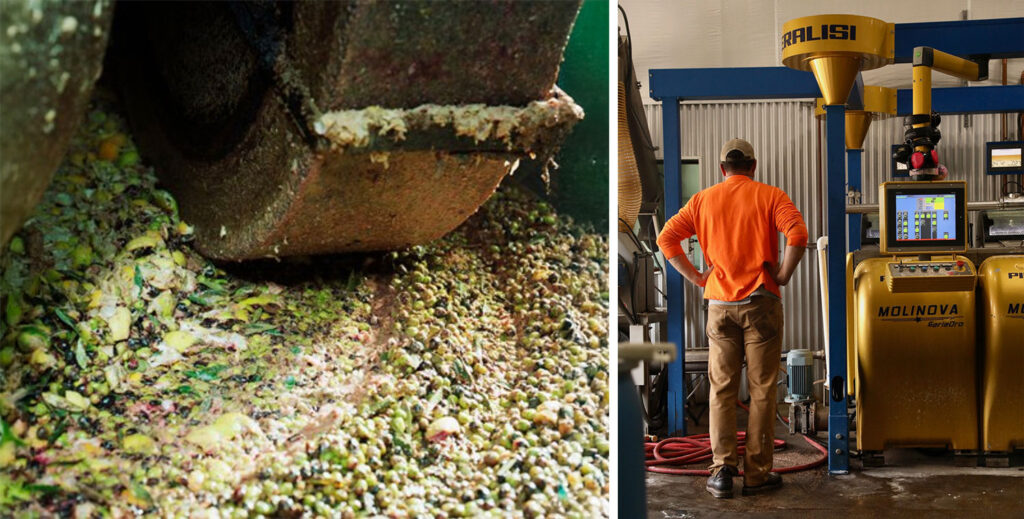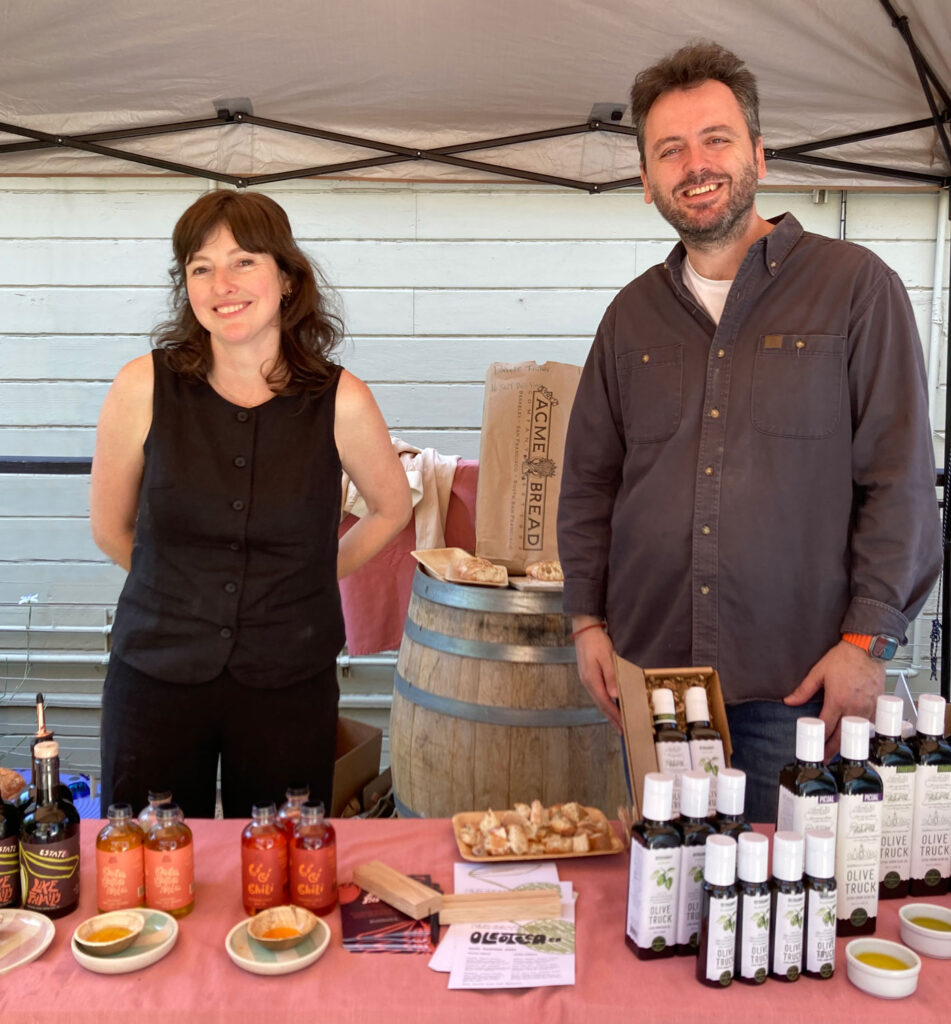What if an Olive and a Chili Pepper Got Married?

What if an Olive and a Chile Pepper Got Married? The answer would be delicious
By Cheryl Angelina Koehler

Jules Pizza Co. is one of the places where Dani Fisher (above) likes to test out her Like Family co-milled oils. The dish of Chef Max Blachman-Gentile’s crudo (below) is seasoned with Like Family’s Il Lime oil. (Photos by Annie Svigals)
Meet Dani Fisher. Like many who regularly peruse these pages, she appreciates living in a vibrant metropolis crammed with casually stylish restaurants offering the vibrant ingredient-driven cuisine our agricultural powerhouse of a state is known for. Like many of us, she also wants to enjoy similar (if simpler) culinary pleasures at home. Unlike a lot of us, Fisher went elbows deep into producing a particular California artisanal ingredient that she adores and wants to provide to chefs and home cooks who share her passions.
“I get very excited with what people are doing in the culinary scene and how we’re eating,” Fisher (42) said over a latte and slice of olive oil apple cake on a fall morning at Berkeley’s Standard Fare. “I love California fruit and produce and food and cooking, and I started thinking about flavors that are exciting to me. I’m inspired by chefs who are doing really simple ingredient-driven food, paired in interesting ways, often using flavored oils as a finishing element.”
Throughout her early career as a food journalist and food stylist, and later as a brand director for the likes of Good Eggs and Blue Bottle Coffee, Fisher never had to go far in her North Oakland neighborhood to find chefs who were doing appealing things with finishing oils. There was Snail Bar’s Chef Andres Giraldo Florez, who before his recent move to the south of France was taking snails, crudo, and oysters into new territory with drizzled-on oil-based flavors. And Daytrip’s Chef Finn Stern, whose salad in a pool of electric-green lemon verbena oil is mythic. But inspiration moved into collaboration with Chef Max Blachman-Gentile at Jules Pizza Co. in San Francisco, where Fisher and business partner Evan Loewy first tested out their Like Family Cí Cí Chili co-milled olive oil on a pizza and their Il Lime oil on the chef’s fish crudo.
Fisher credits reading Extra Virginity, journalist Tom Mueller’s exposé on corruption in the international olive oil trade, for the 2020 epiphany that moved her toward a new career in olive oil. “Many people in my cohort read it and got really excited about olive oil, which I certainly did,” she says.
Olive Oil School
In 2022, Fisher signed up for a course at the UC Davis Olive Center and was soon captivated by a unit on co-milled olive oil presented by Samantha Dorsey, president of Petaluma’s McEvoy Ranch, founded in 1990 by Nan McEvoy.
“Samantha talked about how, for many years, people made terrible, terrible flavored oils with bad, old olive oil and artificial flavoring agents,” Fisher says. “Historically, you’re starting with a [packaged] olive oil and you’re adding something like citrus peel or chili or spice or herbs to it like many chefs do to infuse oil in their restaurants. That oil may be delicious that night at the restaurant, but the item you’re flavoring with causes the oil to go rancid quickly.”

Samantha Dorsey checks the olive trees at McEvoy Ranch. (Courtesy McEvoy Ranch)
The better approach, as Dorsey explained to the class, was co-milling, a process of crushing peak-harvest olives together with whole fresh California produce like citrus, peppers, or fresh herbs, using current state-of-the-art olive milling equipment.
As Fisher understood: “You’re removing all the water and all the plant matter and making sure that all you have left is the oil and even filtering it after. That co-milled oil should taste fresh for a year or two in the same way that extra virgin olive oil should taste fresh for that long if it’s handled properly. I was excited to invest in it and do something really beautiful with it.”
California Co-milling
If you visit Gold Ridge Organic Farms in Sebastopol this season, you might peek through the tasting room window and see the olive mill in operation as you peruse the wide range of local artisan food products on display. Near his 21+ olive cultivars and 70+ varieties of beloved apples in the surrounding orchards, Gold Ridge farmer, founder, and artist Brooke Hazen grows Meyer lemons, yuzu, makrut limes, and a mandarin-kumquat cross that go into co-milling. Ask for a drizzle of the available oils on popcorn or sign up for a scheduled tasting.
Hazen describes the milling: “We basically throw the citrus in the hopper with the olives right before it goes into the crusher, where the blades crush the olives and citrus—skins, seeds, and all—into a slurry.” The slurry churns in slow malaxation and then goes into the centrifuge.

Olives and lemons cohabit in the orchards at Gold Ridge Organic Farms in Sebastopol. Here they are on their way together into the olive mill’s crusher. (Courtesy Gold Ridge Organic Farms)
Greg Traynor, who mills his own and many other California olive oil brands at his 43 Ranch north of Paso Robles in San Ardo, explains that the mill’s centrifuges, plus a set of filters, remove everything but the oils from both the olives and whatever citrus, peppers, or herbs are in the mix, producing co-milled oils that are as stable as extra virgin olive oil.
“We will be making co-mill in chili, citrus, and citrus-ginger,” he texted in October as he was milling Olivaia’s experimental new tomato and dill oils. He planned his own 43 Ranch brand options with the benefit of direct customer feedback from his tasting room. The international crowd of Silicon Valley techies who stop to charge their Teslas at the 12 superchargers in his parking lot tell him how his co-milled oils with Asian character, like his citrus-ginger, quickly add missing flavors of home to their cooking.
Italy Inspires Us Again
Should you be imagining some 16th century Italian olive miller tossing blood oranges in with the olives as oxen turn his stone olive press, in fact, there’s no clear evidence of co-milling going on anywhere in the world before the 1980s. That’s when the Ricci family of Lanciano, Italy, began milling their native gentile di chieti olives together with local citrus varieties (according to a July 2025 story in the Olive Oil Times). The family coined and trademarked the name AGRUMATO for their citrus oils and related products, and that name rumbled with such integrity that some California makers couldn’t resist adopting it for their co-milled oils or using “agrumato method” as an adjective, all prompting cease and desist letters. Rockridge Market Hall shoppers who discovered the Ricci family’s AGRUMATO products on the market’s shelves decades ago appreciate their lemon, blood orange, bergamot, tangerine, and citron oils. The Edible East Bay recipe test kitchen was thrilled with the vibrant AGRUMATO tangerine oil drizzled into Francine Spiering’s Sweet Potato Chocolate Soup (recipe here), and like other lovers of the sweet, dried fruit–studded holiday bread called panettone, we look forward to the Pan’AGRUMATO, which reminds us of how we love substituting olive oil for butter in baking. The Riccis make this panettone in several variations using their various co-milled flavors.

Left: When the Ricci family invented their AGRUMATO co-milled olive oils in 1989, they were still reliant on old technology like this stone mill crushing their citrus and olives. (Courtesy AGRUMATO) Right: Milling has become more prosaic with ultra-modern equipment like this Pieralisi system at 43 Ranch seen here processing Fisher’s Like Family Olive oils. (Photo by Evan Loewy, Like Family)

Cutting open an extra-large loaf of Pan’AGUMATO, Francesco G. Maria Ricci shows off the delicate crumb they achieve when using olive oil instead of butter in a traditional panettone. (Courtesy AGRUMATO)
Spanish missionaries first introduced the olive tree to California in the 18th century, but artisan olive oil production for the commercial market only appeared here in the 1990s. Deborah Rogers, who made a Meyer lemon oil around 1999 at the Olive Press in Glen Ellen, recalls that Greg Hinson of O Olive Oil had already created one three years earlier. Now semi-retired, Rogers stays involved in production at McEvoy Ranch, where a dizzying array of co-milled products keep joining the olive oil tasting lineup. She favors the citrus and chili oils but reaches for the basil when she wants to bring the gorgeous taste of summer into her mid-winter pasta dishes. The rosemary oil, she says, is quite versatile for winter roasting of meats and potatoes and for drizzling on stews and soups.
McEvoy’s Samantha Dorsey is all in with the full range of co-milled options, which she says are great time savers in the kitchen. She describes our current time as a “renaissance moment” for olive oil.
“More people are discovering the extraordinary health benefits of consuming extra virgin olive oil on a regular basis and the wonderful flavor profile it can bring to the table,” she says. The moment has also been accompanied by a broadening of interests toward a full range of international flavors. She pours McEvoy’s ginger-turmeric oil over cauliflower, pops it in the oven, “and boom,” she says, “in half an hour there’s a nice easy roasted dish—you just sprinkle it with a little salt.” She drizzles the chai spice oil over her morning oatmeal and blends it with a little heavy whipping cream for her coffee. “It’s like a Bulletproof keto coffee but without the coconut oil,” she says.
Experimenting with the Elixir
Giulio Zavolta also likes to put a few drops of olive oil in his coffee. He’ll use a pungent Olivaia/OLA extra virgin oil—not a co-mill—that he makes with partner Rachelle Bross in Lindsay, California, where they tend some of the state’s oldest commercial olive orchards.
“I love the way the very green, herbaceous, grassy notes of the Block X combine with the roasted nature of the coffee,” he says. “The second the oil hits the coffee, you’re putting it to your lips and you’re getting all the aromatics. We have been pushing this idea of understanding olive oils as a perfume and as an elixir.”
Zavolta says they resisted doing co-milled oils because they thought of the added flavors as detractions from the extraordinary flavors of their extra virgin oils. But this year, they decided to experiment, and they won’t be using the pungent Block X olives.
“In fact, we’re going to use some of our best olives, our Sevillano, which typically have given us a delicate oil. We’re trying to subtly add flavor to it as an experiment,” he says. “I’m very interested in the idea of tomato, and if it doesn’t work out, at least I get to learn something and will see how I can do it differently because I think there’s something to be said about combining those two together.”
On October 21 at 43 Ranch, Zavolta made three separate small batches: one with tomato, one with dill, and one with two different peppers. Shoppers who hit stores like Oakland’s Rockridge Market Hall at just the right moment could have a chance to try them.

The tree at left in Olivaia’s Block X dates back to a century to when Lindsay area was the table olive capital of the state. Now renovated for olive oil production, Block X produces a pungent olive oil that Zavolta was skeptical of using for their co-milling experiments. Instead they’re going with the delicate oil they get from their huge Sevillano olives. (Photos by Giuliano Zavolta, Olivaia/OLA)
Smart Sourcing
When Dani Fisher began her journey into olive oil production, she was working in partnership with Evan Loewy of Other Brother Co., who had started out making Tuscan-style extra virgin olive oils from his family’s Carmel Valley olives. As Fisher grew more enchanted with the co-milling possibilities, they started by creating a chili oil, testing it out on pizzas they ordered at Jules and getting Chef Max’s input as well.
“We had this idea for a not-too-spicy super-forward pizza oil,” she says.
They used organic peppers grown at Borba Farms in Aromas for what would become the Like Family brand Cí Cí Chili oil. To fulfill her dream of an Italian blood orange–style olive oil, Fisher went to Bryce Loewen, a fourth-generation farmer at Fresno County’s Blossom Bluff Orchards, for Cara Cara oranges to make the Like Family Cara Cara Mia co-milled oil.
“The timing almost always doesn’t work, because you need the fruit to be ripe and pickable when the olives are ripe and pickable,” she says. “It’s like a logistical cluster-fuck. There’s one week in December that’s always a true nightmare: like, I’m at a preschool event and I’m outside in the courtyard phoning everybody saying, ‘how do we do this….’ But that’s the magic, when you figure it out and it’s done.”
She adds that it’s really nice to be able to use seconds from the farms, “like perfect-but-ugly fruits that they can’t really sell for full price at a market, but it doesn’t matter at all for co-milling.”
OleotecaCA

Last May, when Dani Fisher held OleatecaCA at the Vintage Berkeley (aka Vintage on Vine), Sam Bayaktar of Olive Truck joined her with his bergamot co-milled oil and picual and frantoio extra virgin varietal olive oils. (Courtesy Vintage Berkeley)
Fisher knows she’s a small fish in the tide pool that California makers represent in the ocean of global olive oil production. “We are like anybody who’s not one of the big three California producers,” she says. But since a rising tide means more room for small fishes, she created OleotecaCA, a pop-up series held in wine shops to which she invites other local olive oil producers to set up and commune with customers.
“Anybody who walks into a small wine shop is totally there for the conversation about flavor notes and process and terroir,” she says to describe the synergy in such East Bay spots as Of All Places, Vintage Berkeley, and Oakland Yard Wine Shop. “This December [2025] we’re doing an olio nuovo–focused OleotecaCA at Vintage on Vine,” she adds, referring to the rich-green ephemeral olive oils released in traditional celebrations at the start of the olive harvest season. (Read about olio nuovo in this story in our Winter 2021 issue.)
She also has bigger news about OleotecaCA: “We will pop up in Temescal Alley in the old Ali Golden space [off 49th Street between Telegraph Avenue and Clarke Street] from November 15 to Christmas, Wednesday through Sunday, 10am to 4pm, selling and tasting Like Family olio, other small oil producers, and olio-related accoutrements.” ♦
RECIPES
The following recipes suggest specific co-milled oils to include, but keep in mind that the beauty of co-milled olive oils is the way they invite us into our creative spaces.
- Orange Olio-Poached Lamb Shanks with Couscous
- Meyer Lemon Whipped Ricotta on toasted baguette with Dried Thyme Flowers and Salt
- Scallop and Mandarin Crudo
- Sweet Potato Chocolate Soup
- Butternut Squash Galette
WHO MAKES CO-MILLED OLIVE OILS?

Like Family’s CiCi Chili oil pours from a chute at 43 Ranch. (Photo by Evan Loewy, Like Family)
AGRUMATO: lemon, bergamot, blood orange, tangerine, citron. manicaretti.com/producers/agrumato
BONDOLIO OLIVE: mandarin, Hatch chili. bondolio.com
CALIVIRGIN/LODI OLIVE OIL: lemon, lime, blood orange, several chili oils, basil, rosemary, garlic. calivirgin.com
CORTO: chili, lemon verbena. corto-olive.com
ENZO OLIVE OIL: chili, lemon, clementine, basil. enzooliveoil.com
IL FIORELLO: lemon, lime, makrut lime, mandarin, chili, chili-lime. ilfiorello.com
43 RANCH: chili, citrus, citrus-ginger. 43ranch.com
FRANTOIO GROVE: Meyer lemon, chili. frantoiogrove.com
FROG HOLLOW: Meyer lemon. froghollow.com
GOLD RIDGE ORGANIC FARMS: Meyer lemon, yuzu, makrut lime, mandarin-kumquat.goldridgeorganicfarms.com
LIKE FAMILY: lemon, lime, orange, chili. wearelikefamily.com
MCEVOY RANCH: lemon, Thai lime, blood orange, chili, chili-lime, garlic, basil, rosemary, ginger-turmeric, herbes de Provence, chai spice. mcevoyranch.com
O OLIVE: lemon, blood orange, garlic, basil. ooliveoil.com
OLIVAIA/OLA: tomato, chili, dill. olivaiaolive.com
OLIVE TRUCK: bergamot, orange, chili. olivetruck.com
PASOLIVO: lemon. basil. pasolivo.com
ROUND POND: Meyer lemon, blood orange. roundpond.com
SCIABICA: lemon, lime, grapefruit, blood orange, several chili oils, basil, cilantro, rosemary, garlic, and Fiesta Fusion (lime, garlic, jalapeño, cilantro). sunshineinabottle.com
Cheryl Angelina Koehler is the editor of Edible East Bay. Her obsession with olive oil dates back to childhood and the aromas wafting through her Pugliese grandfather’s kitchen as he fried bell peppers, but her long associations with olive oil aficionado Roberta Klugman, various Rockridge Market Hall staff, and many California olive oil producers keep prompting much deeper pursuits.

